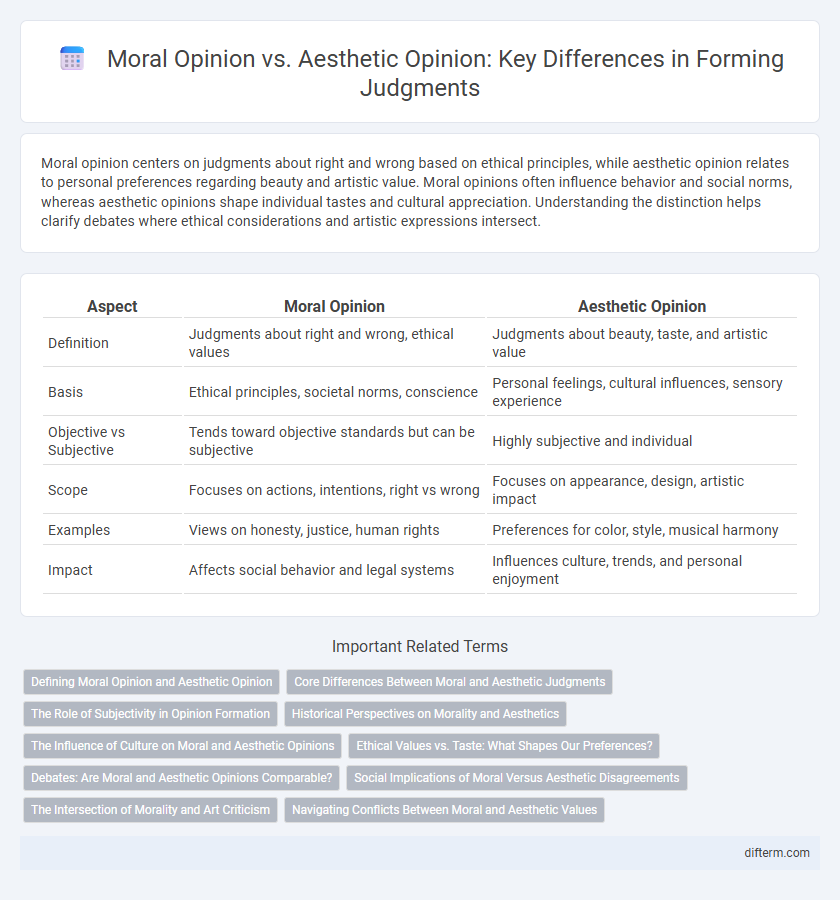Moral opinion centers on judgments about right and wrong based on ethical principles, while aesthetic opinion relates to personal preferences regarding beauty and artistic value. Moral opinions often influence behavior and social norms, whereas aesthetic opinions shape individual tastes and cultural appreciation. Understanding the distinction helps clarify debates where ethical considerations and artistic expressions intersect.
Table of Comparison
| Aspect | Moral Opinion | Aesthetic Opinion |
|---|---|---|
| Definition | Judgments about right and wrong, ethical values | Judgments about beauty, taste, and artistic value |
| Basis | Ethical principles, societal norms, conscience | Personal feelings, cultural influences, sensory experience |
| Objective vs Subjective | Tends toward objective standards but can be subjective | Highly subjective and individual |
| Scope | Focuses on actions, intentions, right vs wrong | Focuses on appearance, design, artistic impact |
| Examples | Views on honesty, justice, human rights | Preferences for color, style, musical harmony |
| Impact | Affects social behavior and legal systems | Influences culture, trends, and personal enjoyment |
Defining Moral Opinion and Aesthetic Opinion
Moral opinion concerns judgments about right and wrong based on ethical principles, often influenced by cultural values and personal beliefs. Aesthetic opinion involves evaluations of beauty and artistic merit, shaped by sensory perception and individual taste. While moral opinions address actions and their ethical implications, aesthetic opinions focus on the appreciation of form, style, and emotional impact.
Core Differences Between Moral and Aesthetic Judgments
Moral opinions center on principles of right and wrong, emphasizing ethical obligations and societal norms, while aesthetic opinions focus on sensory perception, beauty, and artistic value. Moral judgments often involve universal concepts of good and evil, whereas aesthetic judgments are subjective, grounded in personal taste and cultural context. The core difference lies in morality's concern with behavior and consequences, contrasting with aesthetics' emphasis on experience and appreciation.
The Role of Subjectivity in Opinion Formation
Moral opinions often involve deeply held values and principles shaped by cultural, societal, and personal experiences, reflecting a subjective interpretation of right and wrong. Aesthetic opinions center on individual sensory and emotional responses to beauty, art, and taste, highlighting the personal nature of aesthetic judgment. Both types of opinions demonstrate how subjectivity influences the formation of beliefs, emphasizing personal perspective rather than objective fact.
Historical Perspectives on Morality and Aesthetics
Historical perspectives reveal that moral opinions often derive from societal norms and religious doctrines, shaping collective ethical standards over time. In contrast, aesthetic opinions evolve through cultural movements and artistic innovations, reflecting shifting tastes and visual values. Both domains intersect yet maintain distinct criteria, where morality addresses right and wrong, while aesthetics concerns beauty and artistic merit.
The Influence of Culture on Moral and Aesthetic Opinions
Cultural frameworks shape both moral and aesthetic opinions by embedding shared values and norms that guide judgments on right and wrong, as well as notions of beauty and taste. Moral opinions often reflect fundamental societal beliefs about justice, duty, and virtue, while aesthetic opinions are influenced by culturally specific artistic traditions and symbolic meanings. Understanding the cultural context is essential for interpreting how individuals and communities differentiate moral imperatives from aesthetic preferences.
Ethical Values vs. Taste: What Shapes Our Preferences?
Moral opinions are shaped by ethical values that reflect principles of right and wrong, guiding behavior and social norms, while aesthetic opinions are influenced by individual taste and perceptions of beauty or art. Ethical values often stem from cultural, religious, or philosophical foundations, leading to more universal judgments about morality, whereas taste varies widely based on personal experience, cultural background, and emotional response. Understanding the distinction between these types of opinions highlights how our preferences are shaped by both objective values and subjective sensibilities.
Debates: Are Moral and Aesthetic Opinions Comparable?
Moral opinions center on principles of right and wrong, often grounded in cultural, religious, or philosophical frameworks, while aesthetic opinions relate to subjective experiences of beauty and artistic value. Debates on their comparability highlight that moral judgments carry normative weight influencing behavior and social norms, whereas aesthetic judgments primarily reflect personal taste without obligatory consequences. This distinction fuels ongoing discussions on whether evaluating these opinions under a unified framework is valid or if they inherently demand separate criteria.
Social Implications of Moral Versus Aesthetic Disagreements
Moral opinions often carry significant social implications because they influence shared values, community norms, and legal frameworks, affecting social cohesion and justice. Aesthetic opinions, while subjective and varied, typically impact cultural expression and personal identity without directly altering societal structures or ethical standards. Understanding the differing social weights of moral versus aesthetic disagreements helps clarify public discourse and conflict resolution strategies.
The Intersection of Morality and Art Criticism
Moral opinion and aesthetic opinion frequently intersect in art criticism, as artworks often provoke ethical reflections alongside sensory appreciation. The evaluation of art involves not only its formal qualities but also its moral implications, influencing how audiences interpret symbolism, themes, and subject matter. This overlap challenges critics to balance ethical considerations with aesthetic judgments, shaping a complex dialogue between morality and artistic expression.
Navigating Conflicts Between Moral and Aesthetic Values
Navigating conflicts between moral and aesthetic values requires recognizing that moral opinions prioritize principles of right and wrong, while aesthetic opinions focus on beauty and sensory experience. Balancing these perspectives involves critically assessing how artistic expressions align or clash with ethical standards without dismissing the intrinsic value of creative freedom. Understanding the dynamic interplay between ethical imperatives and aesthetic appreciation fosters more nuanced judgments in cultural and social contexts.
Moral opinion vs Aesthetic opinion Infographic

 difterm.com
difterm.com